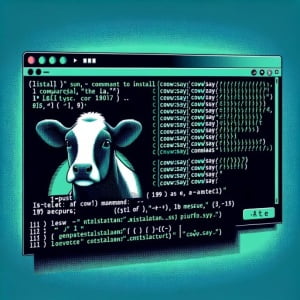How to Install and Use the ‘Cowsay’ Command in Linux

Are you looking to add a touch of humor to your Linux terminal? Like a comic strip in your command line, the ‘cowsay’ command can lighten your day. Many Linux users, particularly beginners, might find the task intimidating. Yet, ‘cowsay’ is a fun command that’s worth mastering. Additionally, it’s readily available on most package management systems, making it a straightforward process once you know-how.
In this tutorial, we will guide you on how to install the ‘cowsay’ command on your Linux system. We will show you methods for both APT and YUM-based distributions, delve into compiling ‘cowsay’ from source, installing a specific version, and finally, how to use the ‘cowsay’ command and ensure it’s installed correctly.
So, let’s dive in and begin installing ‘cowsay’ on your Linux system!
TL;DR: How Do I Install and Use the ‘cowsay’ Command in Linux?
In most Linux distributions, you can install
'cowsay'using the package manager and the commands,sudo [apt/yum] install cowsay. You can then verify the installation with,cowsay 'Installation Successful', which should print a special message if the tool was added successfully.
For example, in Ubuntu, you can run the following command:
sudo apt-get install cowsay
To use it, simply type cowsay followed by your message. Here’s an example:
cowsay 'Hello, Linux!'
# Output:
# _____________
# < Hello, Linux! >
# -------------
# \ ^__^
# \ (oo)\_______
# (__)\ )\/\
# ||----w |
# || ||
This is just a basic way to install and use the ‘cowsay’ command in Linux, but there’s much more to learn about ‘cowsay’. Continue reading for more detailed information and advanced usage scenarios.
Table of Contents
- Installing the Cowsay Command in Linux: A Beginner’s Guide
- Installing Cowsay from Source Code
- Installing Different Versions of Cowsay
- Using Cowsay and Verifying the Installation
- Fun Alternatives to Cowsay in Linux
- Troubleshooting Common Issues with Cowsay
- The Origin and Purpose of ‘cowsay’ in Linux
- The Relevance of Fun Commands in Linux Learning Journey
- Wrapping Up: Installing ‘cowsay’ Command in Linux
Installing the Cowsay Command in Linux: A Beginner’s Guide
The ‘cowsay’ command is a fun program that generates ASCII pictures of a cow with a message. It can be used to bring some humor to your Linux terminal, and it’s a great way to learn about command line programs and ASCII art.
Installing Cowsay with APT
If you’re using a Debian-based Linux distribution like Ubuntu, you can install ‘cowsay’ using the Advanced Packaging Tool (APT). Here’s how you can do it:
sudo apt update
sudo apt install cowsay
This will update your package list and then install the ‘cowsay’ package.
To verify the installation, you can use the ‘cowsay’ command followed by any message. Here’s an example:
cowsay 'Installation Successful'
# Output:
# ________________________
# < Installation Successful >
# ------------------------
# \ ^__^
# \ (oo)\_______
# (__)\ )\/\
# ||----w |
# || ||
Installing Cowsay with YUM
For Linux distributions that use the Yellowdog Updater, Modified (YUM) like CentOS or RHEL, you can install ‘cowsay’ with the following commands:
sudo yum check-update
sudo yum install cowsay
This will check for updates and then install the ‘cowsay’ package.
You can verify the installation similarly to the APT method:
cowsay 'YUM Installation Successful'
# Output:
# ____________________________
# < YUM Installation Successful >
# ----------------------------
# \ ^__^
# \ (oo)\_______
# (__)\ )\/\
# ||----w |
# || ||
These are the basic methods to install the ‘cowsay’ command in Linux. In the next section, we’ll explore more advanced usage of the ‘cowsay’ command.
Installing Cowsay from Source Code
If you want to install ‘cowsay’ from its source code, you can do so by following these steps:
- First, download the source code. You can do this with the
wgetcommand:
wget https://github.com/tnalpgge/rank-amateur-cowsay/archive/master.zip
- Extract the downloaded zip file with
unzip:
unzip master.zip
- Navigate to the extracted directory and run the
install.shscript:
cd rank-amateur-cowsay-master
./install.sh /usr/local
This will install ‘cowsay’ in the /usr/local directory.
Installing Different Versions of Cowsay
From Source Code
If you want to install a specific version of ‘cowsay’ from source, you can do so by specifying the version in the wget command. For example, to install version 3.03, you would use the following command:
wget https://github.com/tnalpgge/rank-amateur-cowsay/archive/cowsay-3.03.zip
Then, you would follow the same steps as above to extract and install ‘cowsay’.
Using Package Managers
APT
If you’re using a Debian-based distribution, you can specify the version of ‘cowsay’ to install with the apt-get command. For example, to install version 3.03, you would use the following command:
sudo apt-get install cowsay=3.03-3
YUM
On a YUM-based distribution, you can also specify the version of ‘cowsay’ to install. Here’s how you can do it:
sudo yum install cowsay-3.03-3.noarch
Version Comparison
Different versions of ‘cowsay’ may have different features or compatibility. For example, earlier versions may not support certain characters or options.
| Version | Notable Features | Compatibility |
|---|---|---|
| 3.03 | Support for multiple characters | Compatible with most Linux distributions |
| 3.04 | Added support for custom options | Compatible with most Linux distributions |
| 3.05 | Improved error handling | Compatible with most Linux distributions |
Using Cowsay and Verifying the Installation
Basic Usage
You can use ‘cowsay’ with a simple command. For example:
cowsay 'Hello, World!'
# Output:
# _____________
# < Hello, World! >
# -------------
# \ ^__^
# \ (oo)\_______
# (__)\ )\/\
# ||----w |
# || ||
This will display a cow saying ‘Hello, World!’.
Verifying the Installation
You can verify that ‘cowsay’ is installed correctly by running the cowsay command with no arguments. If it’s installed correctly, it should display a usage message:
cowsay
# Output:
# cowsay: Could not find any files to use as cows.
# Usage: cowsay [-e eye_string] [-f cowfile] [-h] [-l] [-n] [-T tongue_string] [-W column] [-bdgpstwy] text
This indicates that ‘cowsay’ is installed and ready to use.
Fun Alternatives to Cowsay in Linux
While ‘cowsay’ is a fun and quirky way to add some humor to your Linux terminal, it’s not the only option. There are many other commands and tools that can bring a touch of fun to your Linux terminal sessions. Let’s explore a few of them.
The ‘fortune’ Command
The ‘fortune’ command is a classic Unix program that displays a random message from a database of quotations. It’s a fun way to discover new quotes or sayings. Here’s how you can install it on a Debian-based system:
sudo apt-get install fortune
And here’s an example of how you can use it:
fortune
# Output:
# "It's not the size of the dog in the fight, it's the size of the fight in the dog." - Mark Twain
As you can see, ‘fortune’ can provide a bit of wisdom or humor to lighten your day.
ASCII Art
ASCII art is another fun way to personalize your Linux terminal. You can create your own ASCII art or use a program like ‘toilet’ to generate it for you. Here’s how you can install ‘toilet’ on a Debian-based system:
sudo apt-get install toilet
And here’s an example of how you can use it to generate ASCII art:
toilet 'Hello, Linux!'
# Output:
# _ _ _ _
# | | | | | | |
# | |_| | ___| | |
# | _ |/ _ \ | |
# | | | | __/ | |
# \_| |_/\___|_|_|
As you can see, ‘toilet’ can generate fun and creative ASCII art with just a simple command.
Choosing the Right Tool
While ‘cowsay’, ‘fortune’, and ASCII art are all fun ways to add some humor to your Linux terminal, the best tool for you depends on your preferences. If you enjoy random quotes, you might prefer ‘fortune’. If you like ASCII art, ‘toilet’ might be the best choice. And of course, if you enjoy a talking cow, there’s always ‘cowsay’. The important thing is to have fun and enjoy your time on the Linux terminal.
Troubleshooting Common Issues with Cowsay
Even though ‘cowsay’ is a simple command, you might encounter some issues when using it. Here are some common problems and their solutions.
Cowsay Command Not Found
If you receive a ‘command not found’ error after installing ‘cowsay’, it could be due to several reasons. One of the most common reasons is that the system’s PATH does not include the directory where ‘cowsay’ is installed.
To solve this, you can add the directory to your PATH with the following command:
export PATH=$PATH:/your/directory
Replace ‘/your/directory’ with the directory where ‘cowsay’ is installed.
Cowsay: No Such File or Directory
If you see a ‘No such file or directory’ error when trying to run ‘cowsay’, it could mean that the ‘cowsay’ package is not installed or the system cannot find the ‘cowsay’ command.
You can solve this issue by reinstalling ‘cowsay’ using your package manager. For example, on a Debian-based system, you can use the following commands:
sudo apt-get remove cowsay
sudo apt-get install cowsay
This will remove the existing ‘cowsay’ package and then install it again.
Cowsay: Could Not Find Any Files to Use as Cows
If you see a ‘Could not find any files to use as cows’ error when running ‘cowsay’, it means that ‘cowsay’ cannot find the files it needs to generate the cow ASCII art.
This can be solved by specifying the path to the cow files with the ‘-f’ option. For example:
cowsay -f /usr/share/cowsay/cows/default.cow 'Hello, Linux!'
# Output:
# _____________
# < Hello, Linux! >
# -------------
# \ ^__^
# \ (oo)\_______
# (__)\ )\/\
# ||----w |
# || ||
This specifies the path to the default cow file, which ‘cowsay’ can use to generate the cow ASCII art.
These are some of the common issues you might encounter when using the ‘cowsay’ command in Linux. Remember, the key to troubleshooting is to understand the error message and then find a solution based on that understanding.
The Origin and Purpose of ‘cowsay’ in Linux
The ‘cowsay’ command, like many things in the Linux world, started as a joke. It was created by Tony Monroe in 1999, with the simple aim of generating ASCII art of a cow with a message in a speech bubble. The command quickly gained popularity among Linux users for its humor and simplicity.
The Role of Humor in Linux
Humor plays a significant role in the world of Linux. It’s not uncommon to find funny comments in the source code of Linux programs, and commands like ‘cowsay’ are a testament to this. But why is humor so prevalent in Linux?
One reason is that humor can make the learning process more enjoyable. Learning Linux, especially for beginners, can be a daunting task. There’s a lot to learn, and the learning curve can be steep. Humor can help to lighten the mood and make the learning process less intimidating.
For example, imagine you’re learning how to use the terminal. You could start by learning how to navigate directories or manipulate files. Or you could start by installing ‘cowsay’ and making a cow say ‘Hello, World!’. The latter is undeniably more fun, and it’s a great way to get comfortable with the terminal.
The Importance of ‘cowsay’ and Other Fun Commands
Commands like ‘cowsay’ might seem frivolous, but they serve an important purpose. They make the Linux terminal more approachable and enjoyable, which can be invaluable for beginners. And even for experienced users, these commands can provide a bit of humor and novelty in the otherwise serious world of programming.
Moreover, ‘cowsay’ and similar commands are a great way to learn about command line arguments and options. For example, ‘cowsay’ has options to change the cow’s eyes (-e), tongue (-T), and the type of the cow (-f). By playing with these options, you can learn how command line options work in a fun and interactive way.
To sum up, ‘cowsay’ and other fun commands in Linux serve a dual purpose: they make the terminal more enjoyable, and they provide a unique and fun way to learn about the command line. So the next time you’re in the terminal, don’t forget to have a little fun!
The Relevance of Fun Commands in Linux Learning Journey
Fun commands like ‘cowsay’ are not just for amusement. They serve a greater purpose in the Linux learning journey. They provide a unique and engaging entry point for beginners to familiarize themselves with the terminal. It’s a fun way to learn about command line arguments and options, which are fundamental concepts in Linux.
Exploring Related Concepts: Scripting and Automation in Linux
Once you’re comfortable with basic commands, you can explore more advanced concepts like scripting and automation. Linux scripts are a powerful tool that can automate repetitive tasks, manage system resources, and much more.
For example, you could write a script that uses ‘cowsay’ to display a fun message every time you open a new terminal session. Here’s a simple example of how you might do this:
# Add this to your .bashrc or .bash_profile
echo 'Welcome back!' | cowsay
This will display a cow saying ‘Welcome back!’ every time you open a new terminal session.
Further Resources for Mastering Linux Commands
If you’re interested in learning more about Linux commands, there are plenty of resources available. Here are a few recommendations:
- The Linux Command Line: A Complete Introduction by William E. Shotts Jr. This book provides a comprehensive introduction to the Linux command line, including basic and advanced commands.
LinuxCommand.org is a free online resource that offers tutorials, examples, and exercises on a variety of Linux commands.
Learn the Linux Command Line: Bash Basics on LinkedIn Learning. This course covers the basics of the Linux command line, including navigating the file system, managing files and directories, and using command line tools.
Remember, the key to mastering Linux commands is practice. So don’t be afraid to experiment with different commands and options, and most importantly, have fun with it!
Wrapping Up: Installing ‘cowsay’ Command in Linux
In this comprehensive guide, we’ve explored how to install and use the ‘cowsay’ command in Linux. This fun command brings a touch of humor to your Linux terminal, making your command-line experience more enjoyable.
We began with the basics, learning how to install ‘cowsay’ using package managers like APT and YUM. We then ventured into more advanced territory, exploring how to install ‘cowsay’ from its source code and how to install different versions of ‘cowsay’. We also learned how to use ‘cowsay’ and verify its installation.
Along the way, we tackled common issues you might face when using ‘cowsay’, such as ‘command not found’ and ‘no such file or directory’ errors, providing you with solutions for each issue. We also took a detour to explore fun alternatives to ‘cowsay’, such as the ‘fortune’ command and ASCII art.
| Method | Pros | Cons |
|---|---|---|
| APT/YUM | Easy to install, compatible with most Linux distributions | Limited to available package versions |
| Source Code | Allows specific version installation, access to latest features | Requires compilation, may need dependencies |
| Fun Alternatives | Adds variety, enhances learning experience | May not provide the same humor as ‘cowsay’ |
Whether you’re just starting out with ‘cowsay’ or you’re looking to level up your Linux command-line skills, we hope this guide has given you a deeper understanding of ‘cowsay’ and its capabilities.
With ‘cowsay’ and other fun commands, the Linux terminal becomes more than just a tool. It becomes a playground where you can learn, experiment, and have fun. Happy coding!

